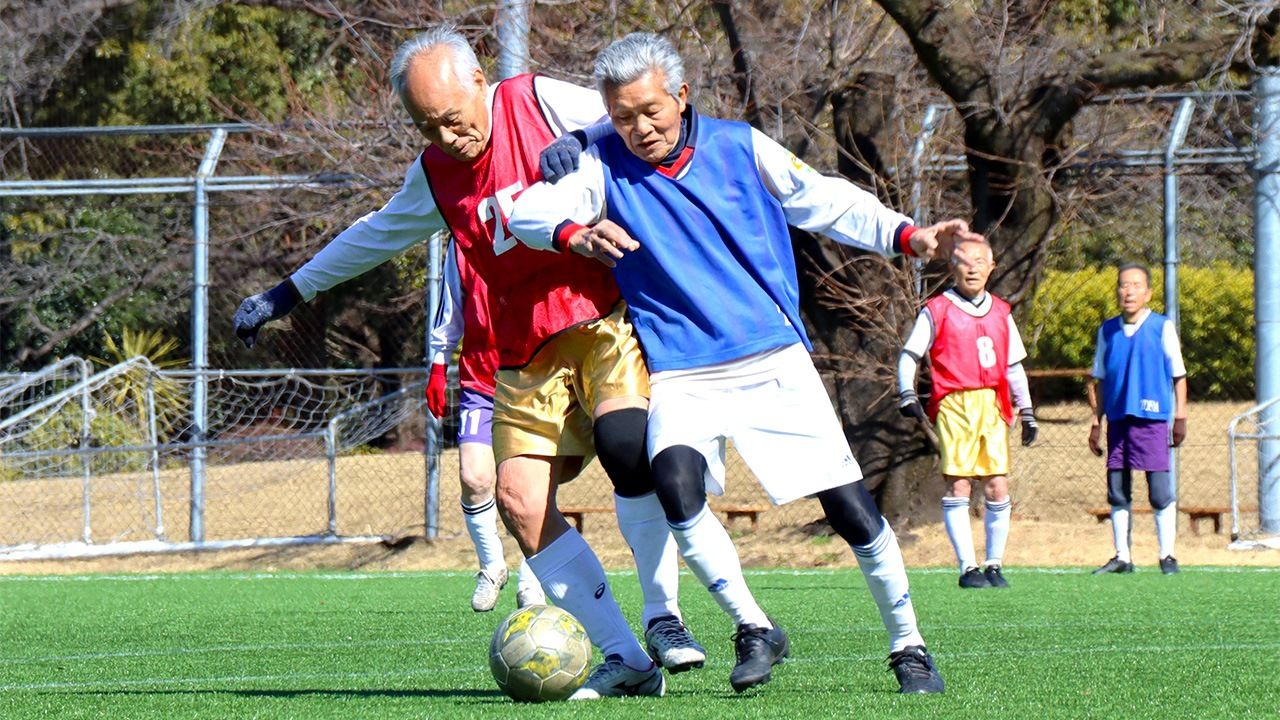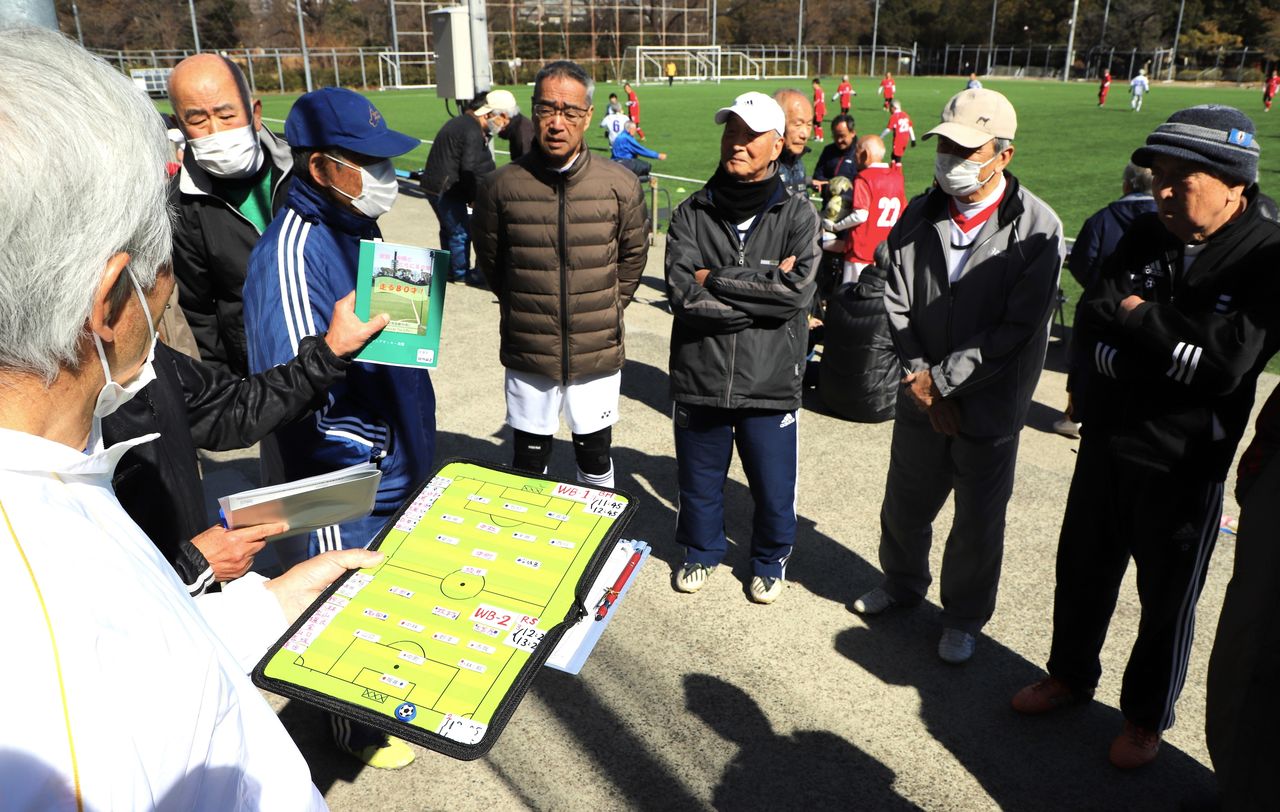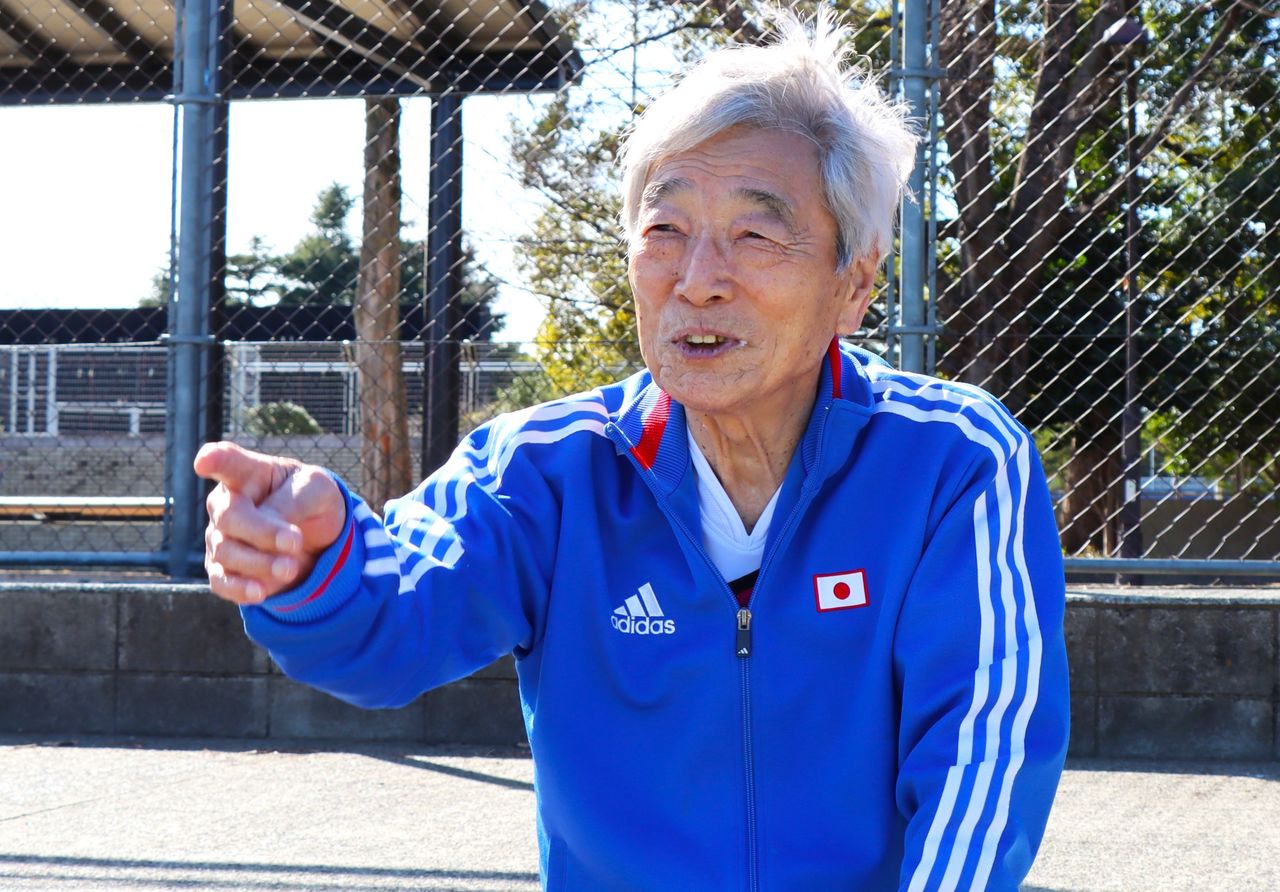
Japanese Senior Footballers Show They Still Have Game in Over-80 Soccer League
Sports Society Health- English
- 日本語
- 简体字
- 繁體字
- Français
- Español
- العربية
- Русский
Sporting Seniors
Japanese people boast the longest life expectancy in the world at 84.3 years. This is according to the World Health Organization’s 2023 World Health Statistics, with the average for men being 81.5 years and 86.9 for women. In September 2023, the Ministry of Internal Affairs and Communications announced that for the first time ever, more than 10% of the Japanese population was over 80 years old.
Part of what keeps many octogenarians going is the desire to remain active. This was the drive behind a senior soccer league specifically for players aged 80 and over that was launched in Tokyo last spring. While there are other competitions for this age group, O-80, as the league is known, is notable in that it features three teams that play several fixtures over the course of a year, rather than a short knockout tournament. It has attracted media attention from around Japan and further afield.
The league’s inaugural season drew 62 players who live in the Tokyo area. Participants were organized into three teams—Red Star, White Bears, and Blue Hawaii—with the roster of each balancing the ages of players.
The 11-a-side games are held on a standard-sized pitch, but there are some concessions to the age of the players. Matches consist of two 15-minute halves, and there are no limits on substitutions. Shoulder charges and sliding tackles are banned, and as a precaution trained staff stand by with automated external defibrillators. The season kicks off in April, with games typically held monthly, although there is a break in July and August when the weather turns hot and matches are canceled at other times when the mercury climbs too high.

Stretching is an essential part of the prematch routine. (© Amano Hisaki)
I attended the last round of matches in February at Komazawa Olympic Park in Setagaya to decide the first O-80 champion. The atmosphere was quite relaxed for such a pivotal event. “It’s been a long time,” remarked one player to a fellow competitor. “How have you been?”
“Still alive and kicking,” came the response. The banter went on like this, with one side talking about recently attending a classmate’s funeral. “When you get to our age, you spend all your time at funerals.” There is a strong vitality among the gray heads and slightly stooped backs, with most sporting eager expressions and boasting firm voices and steady strides.
Expanding Competitions
The sporting organization Tokyo FA Senior, which was launched in 2000, runs the O-80 league, one of seven leagues for players over 40. Veteran member Aoyama Tetsushi gives the history of O-70, O-75, and O-80, which he oversees.
“In the 2008 season, O-60 kicked off with a league of six teams, and new leagues were introduced as the players got older. O-70 began in 2012 and then O-65 and O-75 in 2017, to reduce age gaps. As O-75 players entered their eighties, there was a pre-league competition in 2022 before starting the league competition formally this season.” This makes the players in O-80 pioneers who have made their league possible by continuing their passion for soccer.
The 2023 season saw more than 50 teams and over 1,000 players competing in the four leagues. O-65 led the way with 31 teams and 620 players, followed by O-70 with 18 teams and 449 players, O-75 with 9 teams and 187 players, and finally O-80 with 3 teams and 62 players.
Aoyama himself still plays at the age of 68. “When I was around 50, I never imagined that I’d continue this long,” he says. “It’s because players don’t quit even as they get older that O-80 came about. And as you age, all kinds of problems pop up, so not everybody can keep playing. Around ninety percent of players continue from O-60 to O-70, but then there’s a wall around 75. Many people drop out due to illnesses, poor physical health, or needing to care for their ailing wife.”

Red Star players get ready for their match. The color of their trunks indicate age, with purple signifying a player who is 85 or older. (© Amano Hisaki)
Many on the field have overcome illness or injury to keep playing. Polling players about their health, I get responses ranging from lung cancer to broken bones to multiple cases of COVID-19. “Soccer helps cut your medical costs, so I recommend it to everyone,” one player advises.
Upending Age Conventions
Nearing kick-off time, faces become serious as each team gathers around a tactics board. However, there seems to be a problem for league leader Red Star. Players are trying to reach an absent member, but he won’t pick up his phone. “Try calling his daughter,” someone suggests.
The missing man is 84-year-old Nomura Mutsuhiko, a former Japan international and the top scorer in the first season of the Japan Soccer League (the precursor of today’s J. League). He was inducted into the Japan Football Hall of Fame in 2014. Another O-80 legend is 86-year-old Kim Myong-sik of the White Bears, who was captain of a powerful zainichi ethnic Korean team in the 1960s and 1970s. I had looked forward to seeing both in action, but unfortunately neither make an appearance. Minus Nomura, the Red Star side start the game with 10 players.

Players listen intently during the pre-match strategy session. (© Amano Hisaki)
The last round of matches begins with Blue Hawaii facing off against Red Star. Both teams boast strong formations, building up their attacks with passing and coordinating their defensive tactics. While the pace is notably slower, players still have strong legs, offering a sense of how they performed in their youth.
Voices ring out across the windy pitch. “Watch out behind you!” comes a warning. “Not that way! Go forward!” admonishes another player. The impression is that teams are here not just to play, but to win.

Players move surprisingly nimbly around the pitch. (© Amano Hisaki)

Opposing players chase down a ball in the open field. (© Amano Hisaki)
Many players practice as much as 10 days every month, which is why they move so well on the pitch. Aoyama explains that with more senior players joining, there are weekly training sessions around Tokyo and in nearby Kawasaki and Yokohama.
In one game, a White Bears player dribbles speedily through the opposition and scores a brilliant goal. Aoyama sees me applauding and says, “Great goal. He’s 80 years old,” adding wryly that “he’s still young and quick.” Watching O-80 matches upends conventional views about age.
“Here players get young again every five years,” Aoyama continues. “Someone who’s 79 in the O-75 league can’t move like the 75-year-old players and loses confidence. But when he joins O-80, he transforms into a promising young hopeful, and regains his energy.”
The Secret to Keeping Playing?
Red Star goes on to claim the first O-80 league and is awarded the trophy. After the ceremony, I talk with 86-year-old Handa Susumu of White Bears, who says, “I’m not like all the players here who’ve been playing since they were young. I only began when I was 50.” Handa trains two to three times a week and says he enjoys a post-match drink. “Sake tastes good after you’ve been kicking a ball around.” Smiling, he said he played terribly. “I had a couple of chances, but I rushed and missed them. I want to get a little better and score more goals.”

Handa Susumu of White Bears. (© Amano Hisaki)

Takeuchi Tamio of Red Star. (© Amano Hisaki)
Next, I speak with 85-year-old Takeuchi Tamio of the victorious Red Star team. Having won the national high school tournament together with Nomura in his youth, he can add the first O-80 title to his resume.
“My body declines by the day, and without my buddy Nomura I couldn’t perform well today,” he says. What’s his secret to being able to keep playing so long? “Having a rival like Nomura is really important. But as younger people join, it’s all I can do to keep from being squeezed out. I can’t match their strength, so I have to compete with my head.” A fan of Andrés Iniesta, Takeuchi says he similarly relies on his timing. “If I can maximize my skills and get better, I’ll be back here next season.”
Even as players feel the limits of their aging bodies, they strive to keep improving, helping ensure that their soccer careers will go on.

Red Star celebrate winning the first O-80 league championship.
(Originally published in Japanese on March 29, 2024. Banner photo: Players from Red Star and Blue Hawaii tussle for the ball. © Amano Hisaki.)